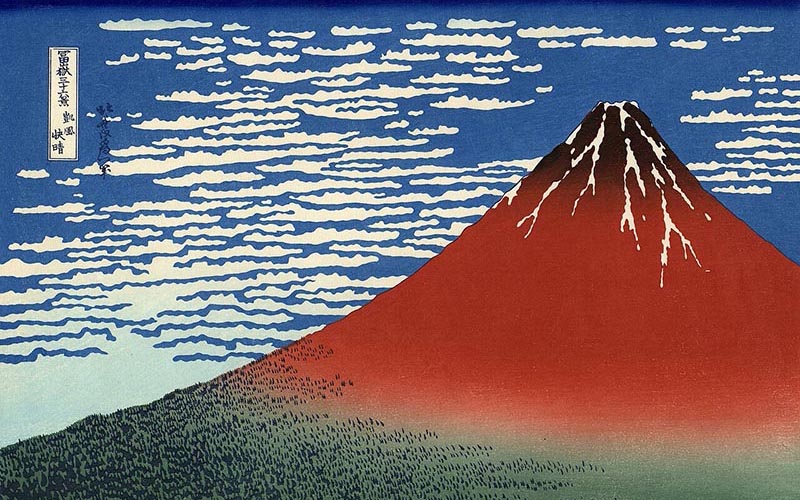
- What is Ukiyo-e? An Overview
- Ukiyo-e works of genre
- Ukiyo-e woodblock print production method
- Famous Ukiyo-e artists and their representative Ukiyo-e works
- Hishikawa Moronobu “Beauty looking back”
- Suzuki Harunobu “Aikido Umbrella in Snow”
- Kitagawa Utamaro “Young lady blowing on a poppin”
- Toshusai Sharaku “Actor Otani Oniji 3rd as the yakko Edobei”
- Katsushika Hokusai”Thirty-six Views of Mount Fuji”
- Utagawa Hiroshige”Fifty-three Stations of the Tokaido”
- Utagawa Kuniyoshi “The haunted old palace at Soma”
- What is the appeal of Ukiyo-e?
- History and Transition of Ukiyo-e
- The Impact of Ukiyo-e on the People of Edo
- How much were Ukiyo-e sold for?
- Ukiyo-e and Edo Shogunate Censorship
- Contemporary Significance and Influence of Ukiyo-e
What is Ukiyo-e? An Overview
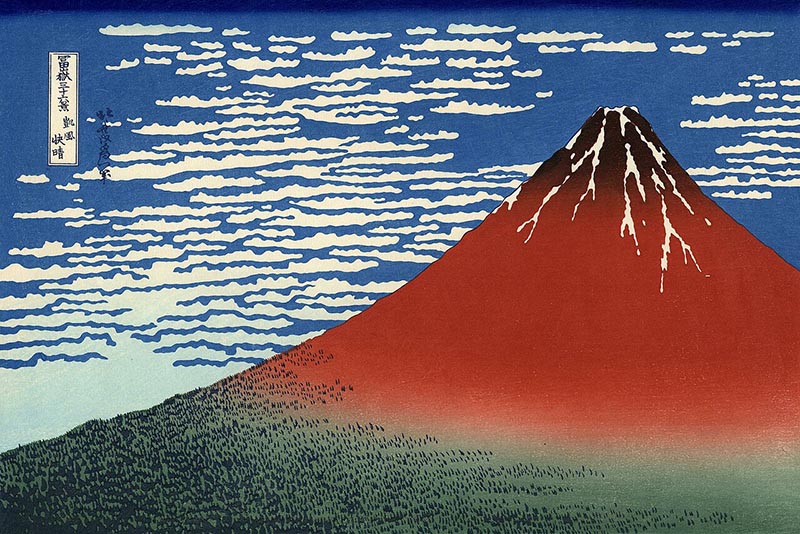
Ukiyo-e is an art of painting that boomed on a large scale as part of the Edo townspeople culture for about 200 years from the early Edo period to the first years of the Meiji period in Japan.
Ukiyo-e focused on subjects which were realistic for Edo people, and a variety of genres such as portraits of actors, beautiful women, and pictures of famous places were produced, by using woodblock printings or hand paintings. It served as a source of information for the common people, which their affordable price and woodblock printings mass production made it possible.
Many Ukiyo-e artists were active in Edo. Ukiyo-e artists, who were ahead of their time, were sensitive to the customs and culture of Edo, and incorporated the latest techniques and designs into Ukiyo-e one after another.
Ukiyo-e works of genre
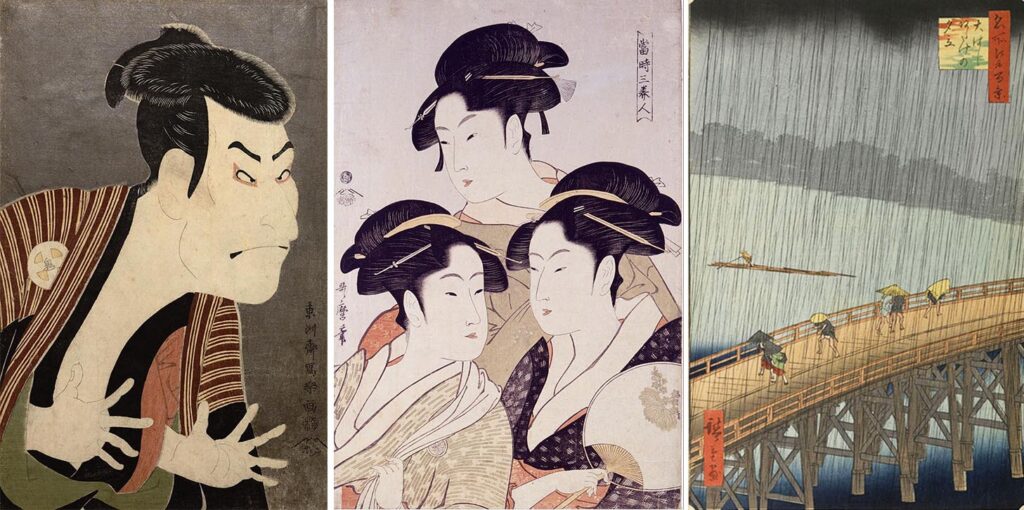
The world of Ukiyo-e has produced works in a variety of genres. These are generally known as follows.
The three major genres of Ukiyo-e are “Yakusha-e” (portraits of actors), “Bijin-ga” (portraits of beautiful women), and “Fukei-ga” (landscapes).
Yakusha-e was the most popular genre of Ukiyo-e in the Edo period, and Ukiyo-e with the names of popular kabuki actors were widely distributed. They were today’s celebrity promido, so to speak.
Bijin-ga was the second most popular type of Ukiyo-e in the Edo period. They were featured on women in various positions, from prostitutes in harsh life to common women.
Fukei-ga was based on the customs, culture, and famous spots of Edo in those days, and the famous place series, which made people yearn to travel, were also popular.
Ukiyo-e also includes other genres such as “Musha-e” (samurai pictures), “Sumo-e” (sumo pictures), “Kacho-ga” (flower-and-bird pictures), “Yurei-ga” (ghost pictures), “Gi-ga” (caricatures), and “Shun-ga” (pornographic pictures), in which famous Ukiyo-e artists competed with each other in skill.
Ukiyo-e woodblock print production method
Ukiyo-e can be classified into two types: “Ukiyo-e woodblock prints”, which are what we generally think of woodblock prints, and hand paintings Ukiyo-e, in which the artists painted directly on the woodblock with their own paintbrush.
Ukiyo-e was widely popular among the common people of Edo because of the influence of woodblock printing technology. Ukiyo-e woodblock prints can be mass-produced and priced inexpensively, making them affordable.
Ukiyo-e woodblock prints are produced by woodblock printing in multiple colors.
Ukiyo-e is produced by ①Ukiyo-e artists make a rough sketch, ②carver carves these designs on several woodblocks, ③a craftsman called “surishi” applies ink and pigments to the woodblocks and adds colors by printing on Japanese paper over and over.
During the Edo period, woodblock printing techniques had been well developed, and made many printing houses capable of printing Ukiyo-e.
Famous Ukiyo-e artists and their representative Ukiyo-e works
Hishikawa Moronobu “Beauty looking back”
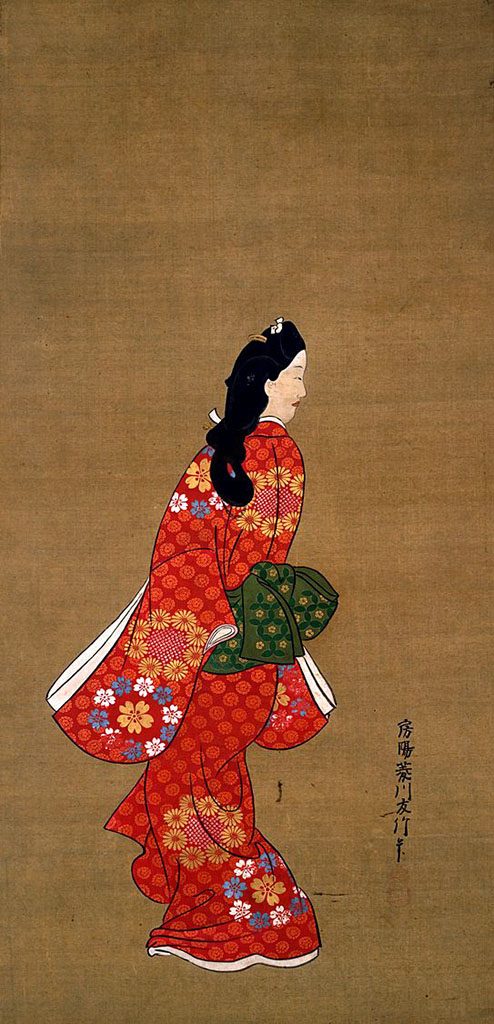
Hishikawa Moronobu (1618-1694), known as “the founder of Ukiyo-e,” stood out himself through his work as an illustrator of printed books, and began to sell them as single prints. He established prints as Ukiyo-e by applying handcolor to black-only woodblock printings. One of his representative works is the Ukiyo-e “Mikaeri bijinzu” (Beauty looking back).
Suzuki Harunobu “Aikido Umbrella in Snow”
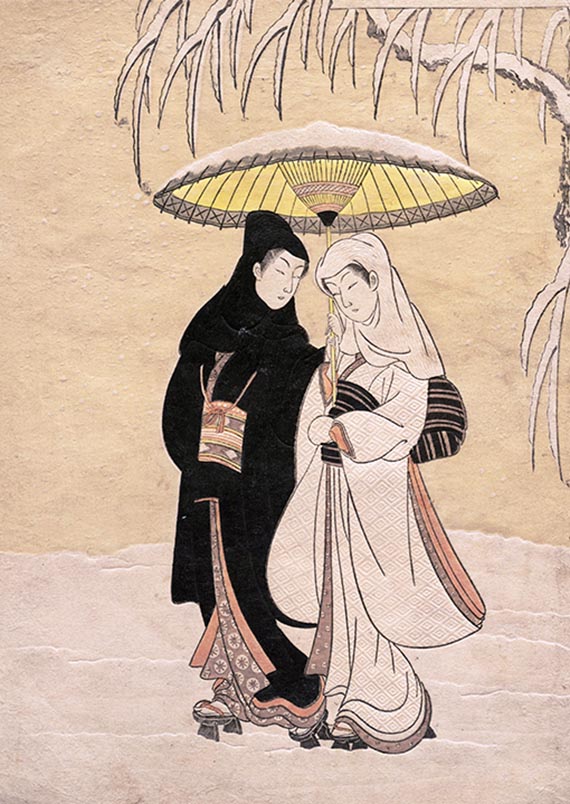
If Hishikawa Moronobu is “the founder of Ukiyo-e,” then Suzuki Harunobu (1725 – 1770) is “the founder of Nishiki-e”. About 100 years after Hishikawa Moronobu’s Ukiyo-e, Ukiyo-e techniques evolved and multicolor printing became common. Suzuki Harunobu created Egoyomi, which is equivalent to today’s calendars, and also perfected the multicolor woodblock print known as Nishiki-e. One of his representative works is “Setchuu aiai-gasa” (Aikido Umbrella in Snow).
Kitagawa Utamaro “Young lady blowing on a poppin”
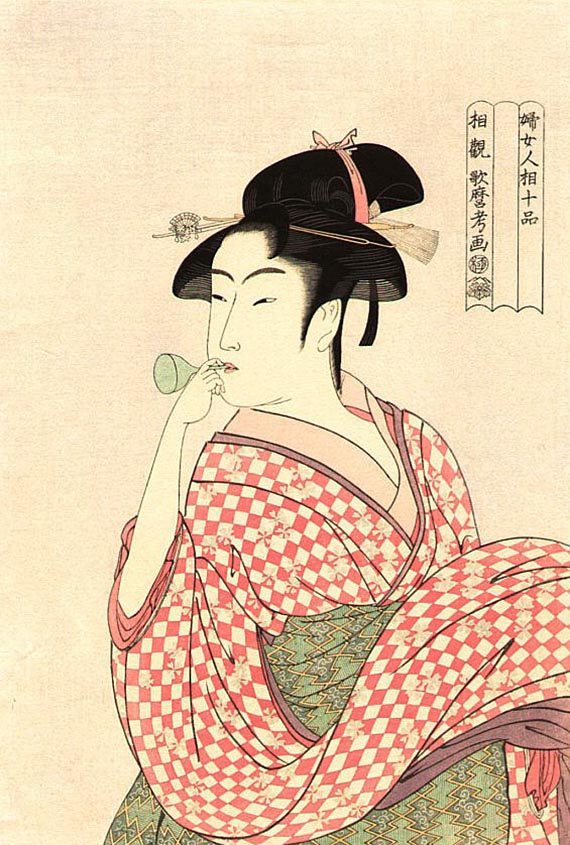
In the mid-Edo period, Kitagawa Utamaro (1753-1806) gained popularity for his paintings of ordinary women and the lives of common people in Edo. His main paintings of beautiful women, “big-neck paintings”, the upper half of a woman’s body, were a big hit. One of his representative works is “Poppin wo fuku onna” (Young lady blowing on a poppin).
Toshusai Sharaku “Actor Otani Oniji 3rd as the yakko Edobei”
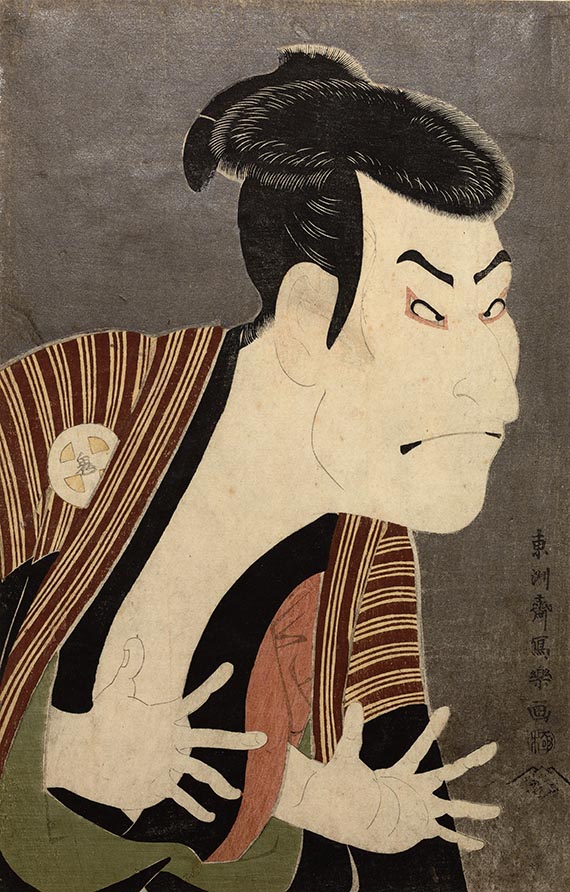
Toshusai Sharaku was an unknown Ukiyo-e artist who suddenly appeared and disappeared after leaving 28 large head paintings behind. While there was a tendency that Yakusha-e (portraits of actors) should be beautiful and cool, his depictions were realistic or beyond realism, so there were pros and cons to his expression. One of his representative works is “Sansei Otani Oniji no yakko Edobei” (Actor Otani Oniji 3rd as the yakko Edobei).
Katsushika Hokusai”Thirty-six Views of Mount Fuji”
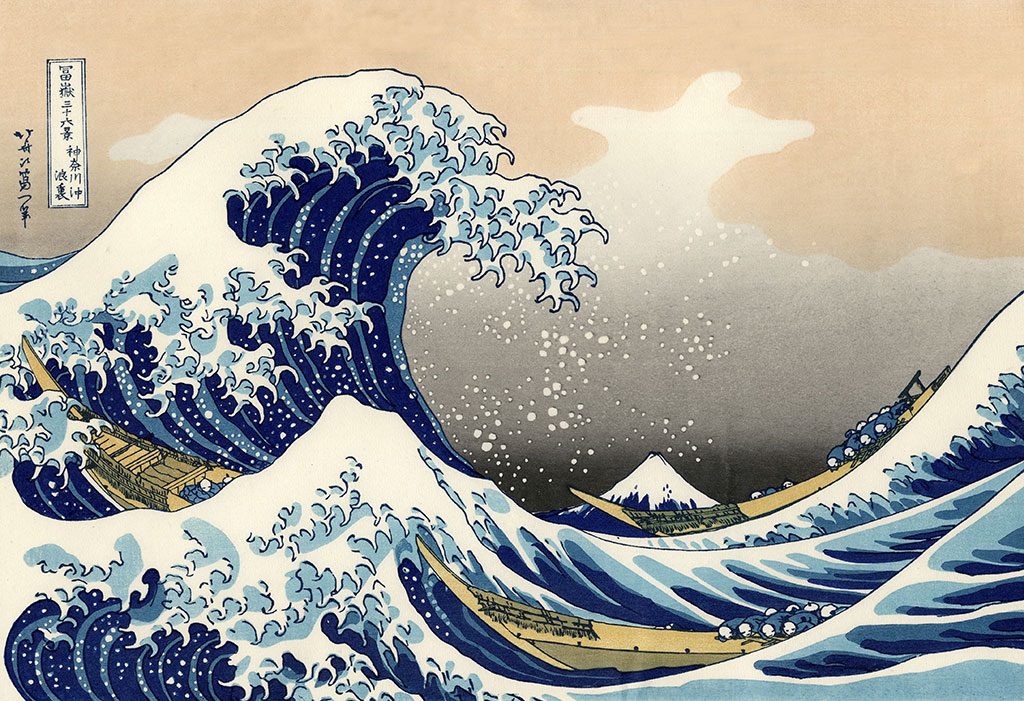
Katsushika Hokusai (1760-1849) was an Ukiyo-e artist with a vitality that kept him constantly seeking new things. He created various genres of Ukiyo-e, including famous place paintings, manga, ghost paintings, pornographic pictures, and original drawing. His representative works are “Fugaku Sanjurokkei” (Thirty-six Views of Mt. Fuji).
Utagawa Hiroshige”Fifty-three Stations of the Tokaido”
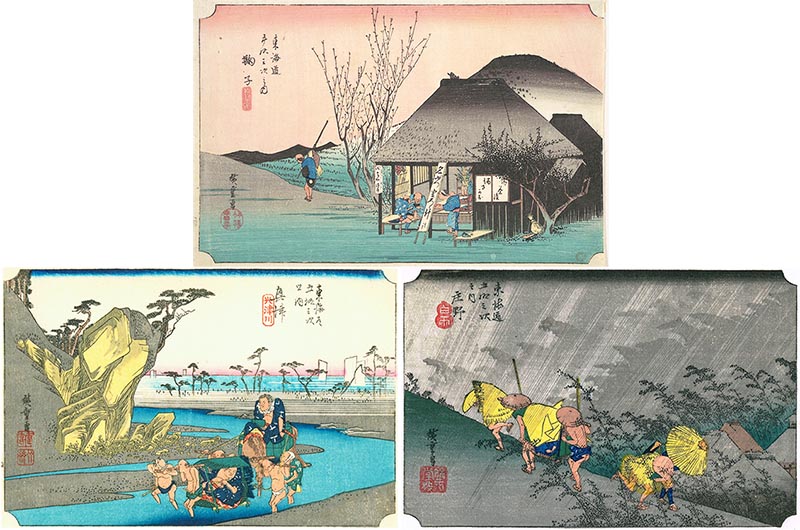
Utagawa Hiroshige (1797-1858) was known as a rival of Katsushika Hokusai, and along with Hokusai, he was an Ukiyo-e artist famous for his series of famous place paintings. His Ukiyo-e, with their emotional and concise lines, stirred the common people’s yearning to travel, and they became a huge hit. His representative works are “Tokaido Gojusan-tsugi” (Fifty-three Stations of the Tokaido).
Utagawa Kuniyoshi “The haunted old palace at Soma”
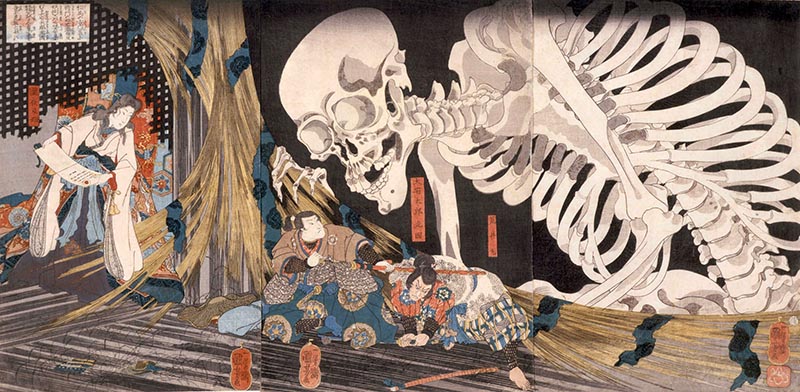
Utagawa Kuniyoshi (1798-1861) was an Ukiyo-e artist known for his three-panel paintings of actors. He became a big seller with his samurai picture series and produced playful and eccentric Ukiyo-e, such as caricatures called “Yose-e”. His representative works is “Soma no furudairi” (The haunted old palace at Soma).
What is the appeal of Ukiyo-e?
Vivid colors from multicolor printing

During the Edo period, when woodblock printings were well developed, many Ukiyo-e were produced in vivid colors by talented carvers and “surishi”. Since there were no photographs, the indigo and other vivid colors of Hiroshige Utagawa’s works, known as “Hiroshige Blue”, enthralled the common people.
Ukiyo-e style and artistic development
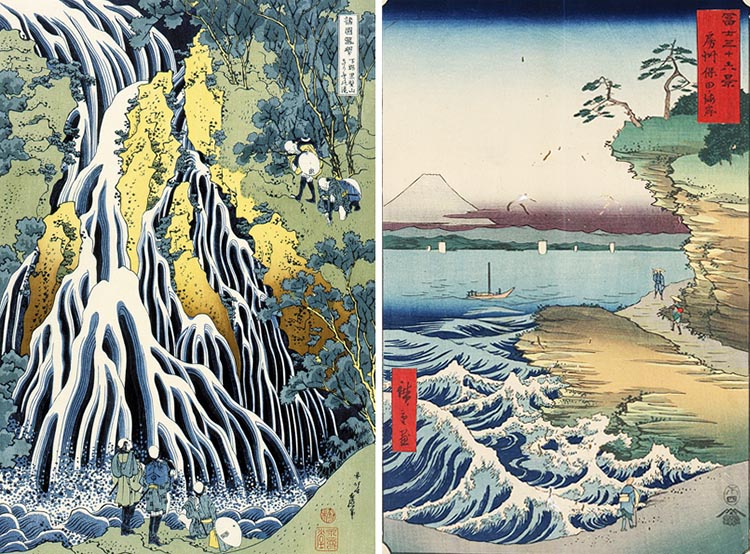
As Ukiyo-e became widely popular among the common people, each Ukiyo-e artists began to actively adopt their own styles and new techniques and to engage in friendly competition. The artistic quality of Ukiyo-e improved dramatically, and they came to be appreciated even by people of high rank, such as samurai warriors.
Ukiyo-e, loved by extending across class boundaries, were also used as souvenirs to the provinces as affordable Edo specialty artworks, and their existence became known to people all over Japan.
Ukiyoe on subjects closely related to the common people
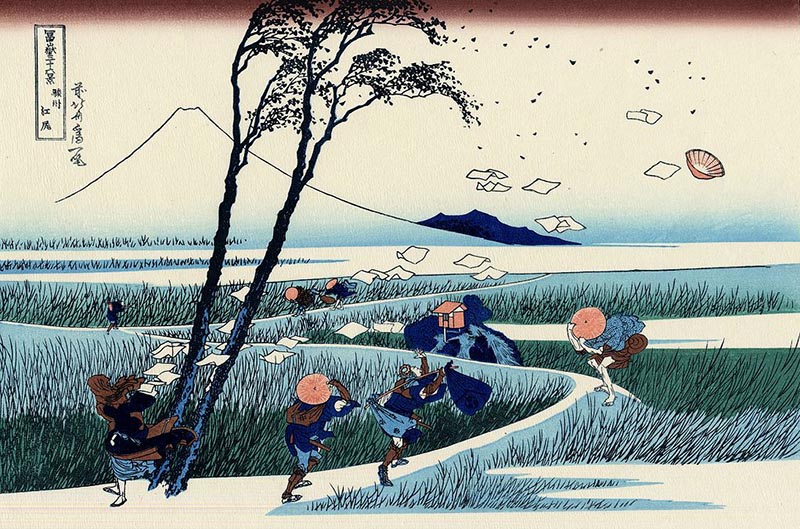
In the Edo period, unique customs and culture flourished and people enjoyed a rich lifestyle. As people improved their lifestyle and they were gradually interested in art and entertainment, many Ukiyo-e works were based on people’s lifestyles, events, and culture. In addition, the Famous Places series by Katsushika Hokusai, Utagawa Hiroshige, and others served as posters for common people to dream of traveling to faraway places they could not actually visit.
History and Transition of Ukiyo-e
Early (early to mid 17th century)
Ukiyo-e originated in the early 17th century. It began with advertisements of traveling actors and Kabuki actors by using woodblock prints. Photography did not exist, so these Yakusha-e played a prominently featured role.
As an artistic movement, the production of works, not only Tosa school and Kano school for the upper classes, but also works based on the customs and manners of the common people, was also a catalyst for a major movement in Ukiyo-e.
Mid-century (mid-17th century – late 18th century)
In the mid-17th century, genres such as “Bijin-ga” and “Fukei-ga” also appeared in Ukiyo-e, and became increasingly popular.
In the 18th century, genres of them increased further with the emergence of Ukiyo-e artists such as Katsushika Hokusai, Utagawa Hiroshige, and Kitagawa Utamaro. These prominent Ukiyo-e artists competed with each other and established their own unique style.
Late (early 19th century to late 19th century)
In the early 19th century, masters like Katsushika Hokusai and Utagawa Hiroshige, who would influence future generations, became active in the Ukiyo-e world.
By the end of the 19th century, the popularity of Ukiyo-e in Japan shrank dramatically due to Meiji Restoration. But at the same time, French impressionist painters paid attention to Ukiyo-e and a Japonism boom took place.
The Impact of Ukiyo-e on the People of Edo
Ukiyoe that transmitted trends and information
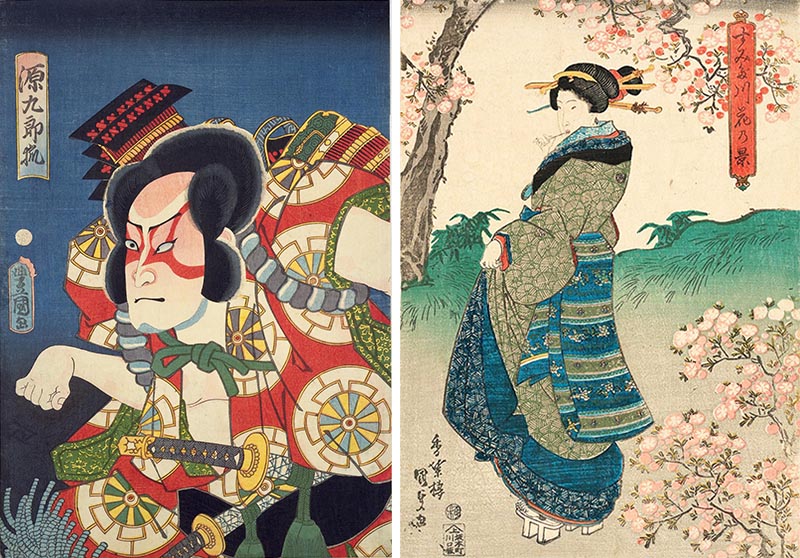
Ukiyo-e had a great influence on the fashion of the common people. “Yakusha-e” and “Bijin-ga” served as what would now be called promoids and fashion magazines and Ukiyo-e was an important source of information for the common people. The women’s fashions and hairstyles depicted in Ukiyo-e had a great influence on the women of the time.
Ukiyoe, an inexpensive and culturally significant contribution to the improvement of culture
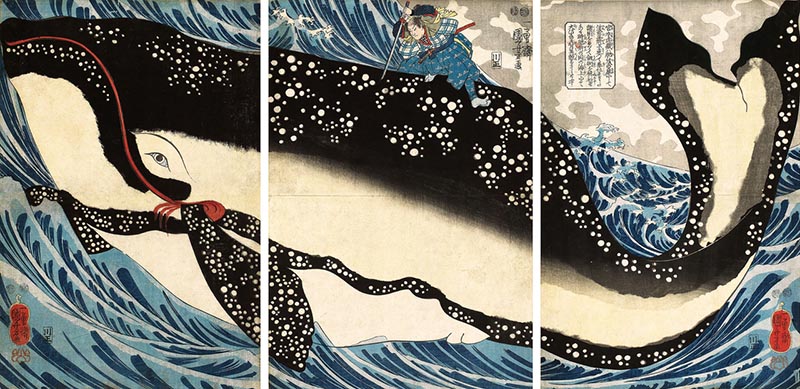
Ukiyo-e prints using woodblock printing were inexpensive and accessible enough for the common people of Edo. The spread of Ukiyo-e in various genres has probably had a significant impact on the culture and society of Edo. Through Ukiyo-e, people learned the joy of appreciating art and experienced for themselves how art could add color to their lives.
How much were Ukiyo-e sold for?
A mass production and a cheap sale of Ukiyo-e woodblock prints made an art form widely available to the common people that had previously been enjoyed only by a few wealthy classes. So how much did Ukiyo-e actually cost in Edo?
Records indicate that during the Edo period, a typical-sized Ukiyo-e was around 16 to 20 bunds, while a large-format Nishiki-e was around 20 to 30 bunds. Additional fees were also set for more time-consuming works or famous Ukiyo-e artists works.
Ukiyo-e price was depending on the genre of the work. For example, the most minor genres like “Kacho-ga” (flower-and-bird paintings) were around 10 kobon, while some of the most major genres like “yakusha-e” (portraits of actors) were around 20-30 kobon.
When we explore the lifestyle of common people at that time, we find records that tofu cost 12 cents per piece and buckwheat noodles cost 16 cents per person. It would be thought that a bowl of soba and a sheet of Ukiyo-e were roughly the same price.
Ukiyo-e was widely loved by the common people of Edo because it was affordable enough for their lifestyle.
Ukiyo-e and Edo Shogunate Censorship
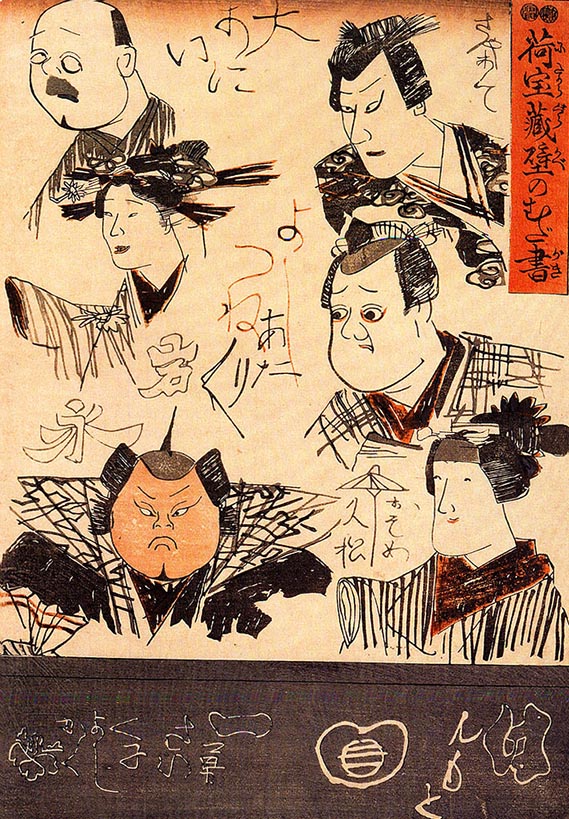
Ukiyoe became widely popular as interest in art and entertainment grew among the common people. Some Ukiyo-e of various customs and culture of Edo contained criticism and sarcasm against the Shogunate.
While allowing the circulation of Ukiyo-e, the Edo shogunate censored Ukiyo-e to prevent them from disturbing the public morals of Edo and spreading criticism of them. The main works subject to censorship were “shun-ga” and Ukiyo-e that undermined the authority of the shogunate. Censored works were stamped with a seal called “kaiin”, which was a sign to prove the work had been censored by the Shogunate.
As censorship imposed restrictions on Ukiyo-e expression, sexual depictions or criticism of the shogunate began to disappear. However, some Ukiyo-e artists rebelled against the censorship. Among the most prominent Ukiyo-e artists were Kitagawa Utamaro, who was punished by the shogunate, and Utagawa Kuniyoshi, who continued to produce ironic and satirical works about the shogunate.
Contemporary Significance and Influence of Ukiyo-e
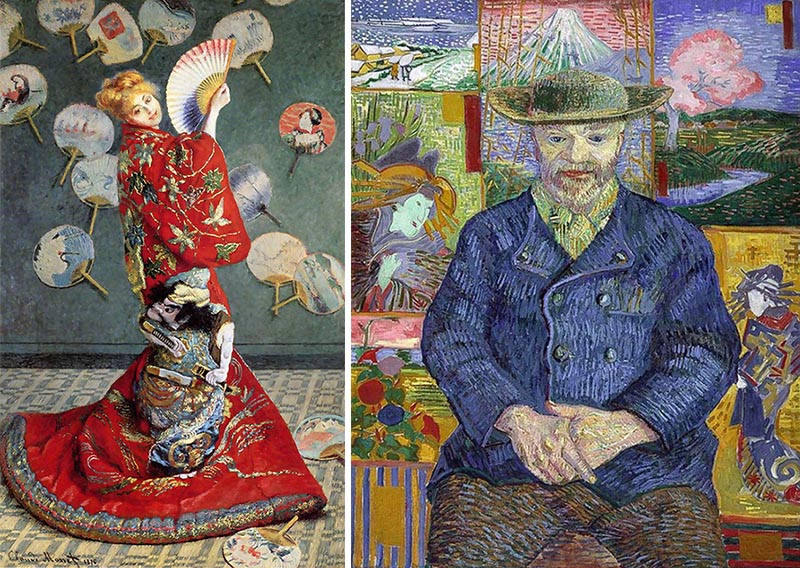
Ukiyo-e art, which dominated the Edo period, declined with Meiji Restoration, but Ukiyo-e has left great significance and influence to contemporary art.
On the other hand, the official exhibition of Ukiyo-e at the Paris Universal Exposition in the late 19th century triggered a Japanese boom in France, known as Japonism. Among them, French impressionist painters were fascinated with Ukiyo-e, and Claude Monet and Vincent van Gogh had large collections with their Ukiyo-e collectors.
Many of Monet’s and Van Gogh’s works show their admiration for Japan and the strong inspiration they received from Ukiyo-e.
Though once declined in Japan, Ukiyo-e is highly valued today not only for its design value but also for its value as a historical document.
Ukiyo-e has influenced many Japanese artists, and its compositions can be seen in the world of Japanese pop culture, anime and manga.
Many museums in Japan and abroad also have Ukiyo-e collections. Overseas, the Metropolitan Museum of Art and other prominent museums have Ukiyo-e collections.






